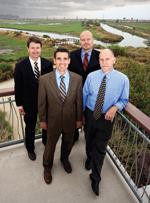Bojeong Kim, Virginia Tech, College of Science
Michelle Pelletier
We’re one step closer to maintenance-free roads. The former University of Rhode Island graduate student developed self-healing concrete by embedding microencapsulated sodium silicate into concrete matrix. When her concrete is put under stress and cracks or fissures are made, the sodium silicate is released and mixes with the calcium hydroxide in the concrete to create a gel-like substance that fills the affected areas. After almost a decade-long exploration into self-healing concrete, Pelletier’s method is the first predicted to be cost-efficient enough to be commercialized.
Gary Gilot
The Indiana public works director’s ground-breaking projects include making South Bend the first city in the world to integrate computerized sensors and motorized controls to prevent combined sewer overflows (see “Real-time sewer solution” from our November 2008 issue). Last month, his department installed pinch valves on a new throttle line to maximize inline and offline storage and control flows into the wastewater treatment plant as it prepares to control the system in real time.
American Recovery and Reinvestment Act of 2009
Why did legislation from last year make o our list? Because it takes at least a year t to gauge the impact of a massive government program that was so quickly formulated and that required equally speedy action from recipients.
On the positive side: first-time stimulus programs are becoming standard operating procedure. Things like the Green Project Reserve that make states invest at least 20% of federally funded loans in sustainable water and wastewater projects. And cheaper financing instruments like the Build America Bond; by May 31 cities, counties, and states were leveraging $106 billion to save $12 billion on water utility and sewer upgrades, highway and airport improvements, and more energy-efficient parking lot and transit facilities.
On the not-so-positive side: more paperwork to prove you’re spending money wisely and paying fair wages, and the (thus far) lack of continuing support for Energy Efficiency and Conservation Block Grants (EECBG), a program created in 2007 but not funded until the stimulus.
And the fatal flaw: public transit.
The U.S. DOT Transportation Investment Generating Economic Recovery (TIGER) grants are extending commuter rail and bus lines, rejuvenating stations and bridges, and adding bicycle lanes in congested areas. But most of the Federal Transit Agency’s $9 billion allocation, including $100 million in grants to reduce emissions, has to be spent on capital investments.
As anyone who’s struggled to extend the serviceability of a road or sewage pipe knows, our train and bus managers are going to need more flexibility and funding if the United States is to operate “sustainably.”














